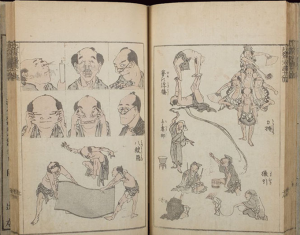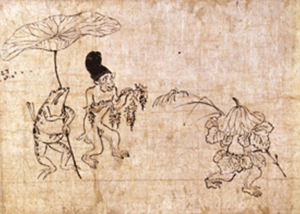The intellectual property (IP) licensing has gone a long way with the pace of technology…
IP Issues in The World of Japanese Sequential Art – Manga
INTRODUCTION
[Image Sources: Tokyo National Museum]
Manga can be best defined as sequential art presented with an illustrative narration of a story. The earliest example of Japanese sequential art can be traced back to the 12th century, Choju Jinbutsu Giga animal scrolls,created by a group of manga-ka (manga creator) whose unique technique of drawing characters to simulate the running form is said to be adopted by several manga-ka even today. However, the word manga was first used in 1798 to describe the picture book, Shiji no Yukikai (Four Seasons) by SantōKyōden and it later emerged in 1814 with the title Aikawa Mina’s Manga hyakujo depicting a series of scenes from daily life ‘whimsical stories’, by a celebrated piece of woodblock print by a ukiyo-e artist,Katsushika Hokusai who ended up creating around 30,000 works in his lifetime.Four blocks in a page were first introduced and published by Kitazawa Rakuten in the year 1902.After ward, the second world war did pose an interruption in the steady growth but in turn, it scaled the manga market to a whole new different level in 1947.
[Image Sources: Tokyo National Museum]

IP ISSUES CREATED BY THE MANGA FAN BASE
Due to the growing interest of the world in Mangas several rights of a manga-ka are challenged. The Mangas are generally published in their native language, i.e., Japanese language which the fans tend to scan after purchasing ‘Raws’ or a copy of the original Japanese version of the manga or downloading scanned Japanese raws from English ‘raws web sites’ or peer-to-peer file-sharing websites in Japan and then translate them from Japanese to the language (‘fan subs’) of their choice and release the translated version free on the internet. This phenomenon is known as ‘Scanlation’. It is driven by two main factors i.e., firstly, the exceeding demand for manga outside the jurisdiction of Japan and secondly to promote Mangas to non-Japanese-speaking countries. This poses high-level threats to the copyright of the creator because as soon as something is released in the market of the home country, the content is scanned and dispersed almost instantly in different languages infringing the personal rights of the creator to protect their content against unsolicited adaptation and translations, bestowed upon them under Article 27 of the Japanese Copyright Laws. There is no question of fair use as although it is not commercially beneficial but it is neither limited to private use. This makes it difficult for the creator to control the dissemination of their works. However, the manga industry does not raise much voice against such atrocities and there seems to be an understanding between the industry and the perpetrators. No strict actions are taken against these infringements; in fact, in a Supreme Court case in Japan in 2009[1] the creator of file sharing program known as ‘Winny’ was not found guilty of infringing content through providing file-sharing software and his actual intent of legitimate legal use was considered over the alleged infringement. However, the US Court has held Napster[2], which was a file-sharing platform as well, guilty of infringing copyrighted materials and was denied the defence of fair use.
For content piracy, Take shobo Inc., one of the major publishers based in Japan sued Cloud flare in 2022,for distributing data of copyrighted works for manga piracy sites by illegally uploading them and making them available for free, consequently, infringing the copyrights of the publisher. They sought an injunction and a compensation of 460 million JPY (around $4 million USD).
[Image Sources: Shutterstock]

‘Makaizo’, meaning ‘devil’s modification’ is a technique in which the body of a popular anime figure gets swapped for that of another.
The Kyoto Prefectural Police arrested a 54-year-old man from Tsuyama City for selling modified figurines of Evangelion here by infringing its copyright. He purchased figures of Asuka and swapped their heads and bodies and sold that for 10,000 JPY ($75 USD) for more than a year accounting for around 1.8 million JPY ($13,500 USD). He was charged for counterfeiting the base figures.
MASSACRE OF INTELLECTUAL PROPERTY RIGHTS BY ARTIFICIAL INTELLIGENCE
Due to technological advancements, Japan is estimated to be bombarded with new kinds of infringement caused not only by the fans but by Artificial intelligence as well. Japan has opened its gates and has welcomed AI with open arms. Japan is currently considered as the AI heaven for all the tech-rats; the reason for this is the upliftment of copyright restrictions on copyrighted materials when incorporated into the AI database. This has been affirmed by Keiko Nagaoka, the Japanese Minister of Education, Culture, Sports, Science, and Technology.This provision will allow rampant copyright infringement in the name of supporting technological advancements. As welcoming as it may sound, it poses high-level threats to manga creators. They already face a hard time protecting their rights due to the already existing illegal indulgence of the fans, this will add on to their misery.
There are existing AI databases that are specifically run to aid the need to create manga art blocks by referring to an enriching database of already existing templates. Without the knowledge of infringement, the creators will be impaired. This will thereby lead to the manga-ka facing high threat to their employment which will gradually lead us to witness the extinction of the world-famous Japanese sequential art- manga.
CONCLUSION
Due to increasing awareness of intellectual property, people have started taking some meaningful actions other than mere requests for taked owns by the CODA (Tokyo-based Content Overseas Distribution Association). Manga-ka has also started producing official translations in collaboration with fans overseas and publishing them online by the end of 2021. However, there are no steps taken by the Japanese government in preserving, protecting, and uplifting the rights of manga-ka, moreover burdening them further with free incorporation of copyrighted works in AI databases without consequences or prior authorisation. This seems to be the doom of a well-renowned art form unless positive actions are taken to control the same.
Author : Soumi Lahiri, A Student at University of Petroleum and Energy Studies in case of any queries please contact/write back to us via email to chhavi@khuranaandkhurana.com or at IIPRD.
[1]SaikōSaibansho [Sup. Ct.] Dec. 19, 2011, 2009 (A) No. 1900, 65 SAIKŌ SAIBANSHO KEIJI HANREISHŪ [KEISHŪ] 1(Japan).
[2]A&M Records, Inc. v. Napster, Inc., 239 F.3d 1004, 1021, 1022 (2001).
[3] V.T. Thomas Versus Malayala Manorama Company Limited AIR 1988 Ker 291.
[4]Star India v. Leo Burnett (India) Private Limited (2003) 27 PTC 81




